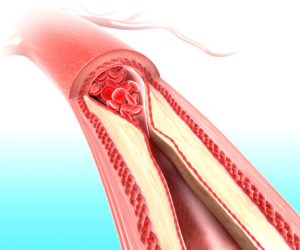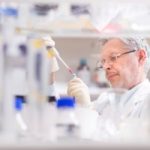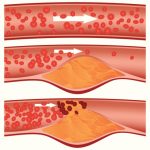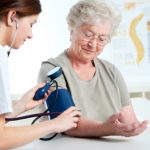 Researchers have developed a tool to identify high risk atherosclerotic plaques, often referred to as inflamed fatty deposits, to help fight cardiovascular disease. Coronary artery disease is the number one killer of Americans, so the new research is welcome news to medical experts trying to help fight cardiovascular disease.
Researchers have developed a tool to identify high risk atherosclerotic plaques, often referred to as inflamed fatty deposits, to help fight cardiovascular disease. Coronary artery disease is the number one killer of Americans, so the new research is welcome news to medical experts trying to help fight cardiovascular disease.
Atherosclerosis is the hardening of the arteries. It happens when deposits of fatty substances, cellular waste products, cholesterol and calcium build-up in the inner lining of an artery.
Advertisement
Over the last few decades we have seen a decrease in mortality linked to atherosclerosis plaques and other coronary ailments. Studies suggest that changes in therapies and in lifestyle may be the reasons; however, it is expected that despite this progress, in the next 20 years heart disease will become one of the leading causes of death around the world.
Unlike a heart attack or stroke, coronary atherosclerotic disease can begin without symptoms. Sometimes it can present itself much like an angina attack. This is because coronary flow is decreased. In other cases, sudden rupture of plaque triggers acute coronary syndrome, including unstable angina, heart attack or even sudden death.
New tool to detect atherosclerotic plaque rupture risk developed
 Researchers from Boston University School of Medicine, along with experts at the University of California, San Diego have been able to validate two fluorescent probes called Activatable Cell Penetrating Peptides or ACPP’s, using an experimental model. The probe was used to detect the severity of atherosclerotic plaques. The research team has indicated that their probes were able to distinguish high-risk plaques with high sensitivity and pinpoint vessels that have multiple plaques.
Researchers from Boston University School of Medicine, along with experts at the University of California, San Diego have been able to validate two fluorescent probes called Activatable Cell Penetrating Peptides or ACPP’s, using an experimental model. The probe was used to detect the severity of atherosclerotic plaques. The research team has indicated that their probes were able to distinguish high-risk plaques with high sensitivity and pinpoint vessels that have multiple plaques.
Atherosclerosis or hardening of the arteries is considered a complicated disease since it comes in many stages. It can be called stable or unstable. In the most advanced stage, higher risk, unstable plaques can suddenly form a clot in the vessel, leading to a heart attack or stroke. Right now, there are many imaging methods that are making headway in detecting vulnerable plaques; however, few are able to focus on blood clots.
The researchers from Boston and California hope to develop a system of ACPP’s with MRI probes for diagnostic purposes within humans.
Atherosclerosis and plaque attacks
 Atherosclerosis plaques work in different ways. In some instances they can remain within the artery wall where the plaque grows to a certain size and then stops. It may never cause symptoms since it does not block blood flow. In other cases, plaque can grow in a slow fashion, way into the path of blood flow. This can cause blockages and symptoms of pain upon exertion in the chest or legs. In the worst-cases, plaques suddenly rupture. In this situation the rupture allows blood to clot inside an artery. In the heart this causes a heart attack, and in the brain it causes a stroke.
Atherosclerosis plaques work in different ways. In some instances they can remain within the artery wall where the plaque grows to a certain size and then stops. It may never cause symptoms since it does not block blood flow. In other cases, plaque can grow in a slow fashion, way into the path of blood flow. This can cause blockages and symptoms of pain upon exertion in the chest or legs. In the worst-cases, plaques suddenly rupture. In this situation the rupture allows blood to clot inside an artery. In the heart this causes a heart attack, and in the brain it causes a stroke.
Plaques can cause three kinds of cardiovascular disease (CVD).
- Coronary artery disease:
Stable plaques in the heart’s arteries cause chest pain upon exertion. Sudden plaque rupture and clotting can cause heart muscle to die, which leads to heart attack.
- Cerebrovascular disease:
This happens when ruptured plaques in the brain’s arteries cause stroke with potential for permanent brain damage.
- Peripheral artery disease:
This occurs when narrowing of the arteries in the legs is caused by plaque and the result is poor circulation. In some cases it may lead to amputations.
Understanding stable plaques vs. unstable plaques that rupture
As mentioned above, plaques can grow in size. This can cause arteries to narrow and stiffen. This reduces the flow of oxygen-carrying blood. As the contents of the plaque spill into the bloodstream following a rupture, a blood clot forms at the site where the plaque originated. That clot can grow until it completely blocks the blood supply to a part of the heart. If this goes on for more than 20 or 30 minutes, the heart muscle dies. Doctors now know that some plaques are less likely than others to rupture.
A lot of research has been conducted on stable verses unstable plaques. Stable plaques have a thick fibrous cap over a small fatty core. They are rich in collagen, which is a protein found in connective tissue. It seems to stabilize the plaque, making it less likely to rupture. Unstable or vulnerable plaques have a thin fibrous cap over a large fatty core. They develop as large amounts of LDL cholesterol build up in the plaque. The fatty core expands and the cap starts to erode. At the same time this is happening, inflammation within the plaque causes collagen in the cap to break down. As a result, the fibrous cap becomes weak and can rupture.
Preventing atherosclerosis plaque buildup
 Atherosclerosis plaques get worse over time, but there is a way to lower the risk of rupture or prevent the plaques all together. Research shows that 90 percent of heart attacks are due to the following risk factors:
Atherosclerosis plaques get worse over time, but there is a way to lower the risk of rupture or prevent the plaques all together. Research shows that 90 percent of heart attacks are due to the following risk factors:
- Smoking
- High blood pressure
- Diabetes
- High cholesterol
- Obesity
- Excessive consumption of alcohol
- Sedentary behavior
- Stress
- Not eating enough fruits and vegetables
One of the best things you can do is adopt a heart healthy diet. The American Heart Association recommends nutrient rich foods that have minerals, proteins, whole grains and other nutrients that are low in calories. They will help control weight, cholesterol, and blood pressure. A heart healthy diet includes, low fat dairy products, fresh fruits and vegetables, skinless poultry and fish, and non-tropical vegetable oils.
Advertisement
Your diet should also limit saturated fats, trans fats, sodium and red meats, as wells as sweets and sugar-sweetened beverages.
According to the Centers for Disease Control and Prevention, over 600,000 people die every year in the United States from heart related diseases. That’s one in every four deaths.
The chances of surviving a heart episode are much higher when treatment begins quickly, so if you think you are at risk of cardiovascular disease, talk to your doctor. He or she can teach you everything you need to know about warning signs and becoming heart healthy.
